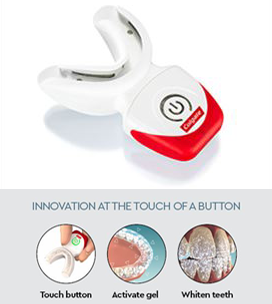COLGATE PROFESSIONAL
A Positive Reaction in Teeth Whitening
Colgate Optic White Professional uses advanced ionic technology to keep patients comfortable while delivering fast and noticeable results
 The practice of teeth whitening may seem like a fairly recent addition to dentistry, especially in today’s selfie and social media-laden culture. But that couldn’t be further from the truth. From ancient Egyptians who showed their creativity by making whitening pastes from ground pumice stone mixed in wine vinegar, to the more recent discovery in the late 1980s that peroxide, when used as an oral antiseptic, had the unexpected side effect of whitening teeth.
The practice of teeth whitening may seem like a fairly recent addition to dentistry, especially in today’s selfie and social media-laden culture. But that couldn’t be further from the truth. From ancient Egyptians who showed their creativity by making whitening pastes from ground pumice stone mixed in wine vinegar, to the more recent discovery in the late 1980s that peroxide, when used as an oral antiseptic, had the unexpected side effect of whitening teeth.
Fast-forward to today where most in-office whitening systems use light or heat to activate whitening gel and lighten tooth shade. Colgate Optic White Professional, which was introduced last year and is now being launched nationally, takes a different approach.
Available exclusively to dental offices, the innovative whitening system uses advanced ionic technology to deliver over seven shades of improvement in a single 30-minute in-office treatment. Patients also can whiten at home with an at-home whitening kit that delivers the same noticeable whitening results through 10-minute treatments over 10 days.
An Ionic Solution to Sensitivity
 So, how does it work? The whitening system revolves around an adaptable and universal soft silicon tray and mouthpiece. A specially formulated gel inside the tray maximizes whitening performance. When a button on the mouthpiece’s reusable handle is pushed, a gentle, precisely controlled electrical current is delivered—stimulating a pH change in the formula that drives peroxide activity and is designed to produce no tooth sensitivity.
So, how does it work? The whitening system revolves around an adaptable and universal soft silicon tray and mouthpiece. A specially formulated gel inside the tray maximizes whitening performance. When a button on the mouthpiece’s reusable handle is pushed, a gentle, precisely controlled electrical current is delivered—stimulating a pH change in the formula that drives peroxide activity and is designed to produce no tooth sensitivity.
“By using ionic technology instead of heat to activate hydrogen peroxide, we eliminate sensitivities from heat, and the teeth remain hydrated during treatment,” said Dr. Sibel Antonson, who has treated numerous patients successfully using Colgate Optic White Professional. “So basically, we are solving two of the major issues seen with other in-office bleaching systems.”



